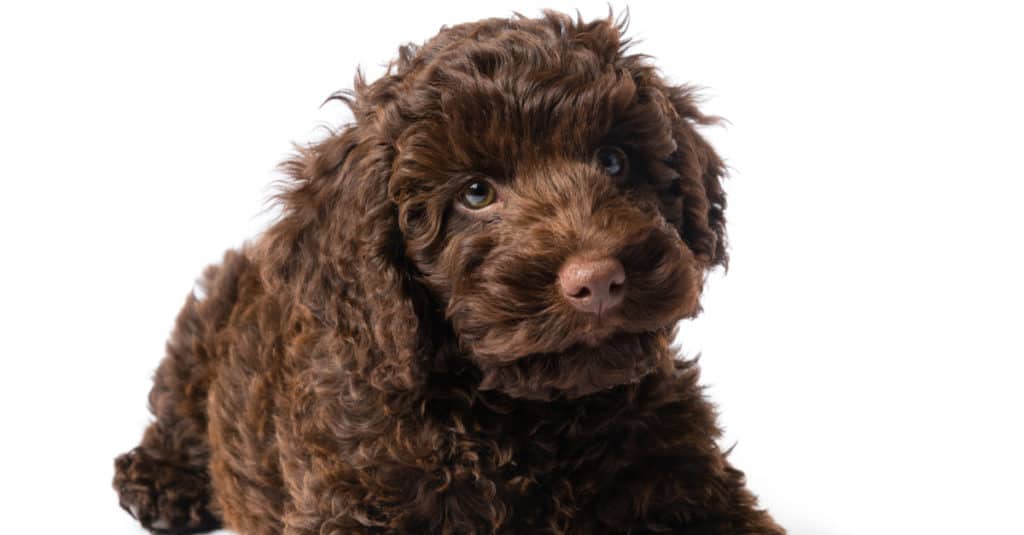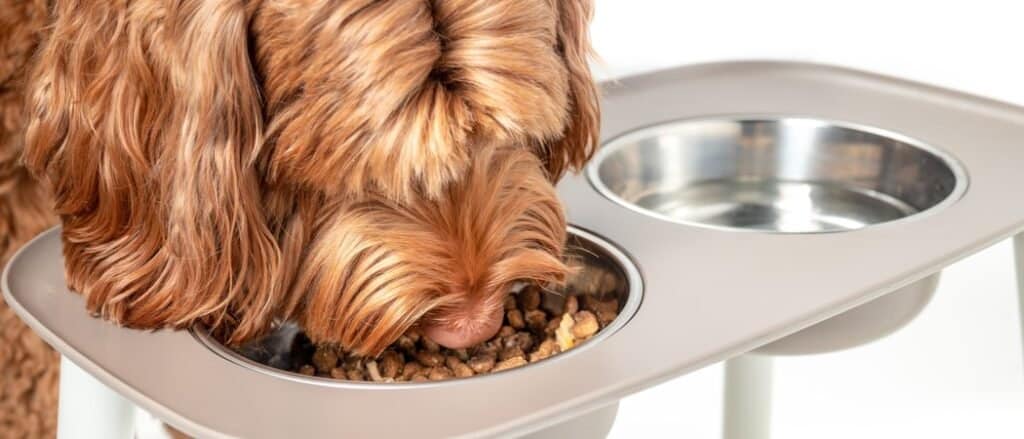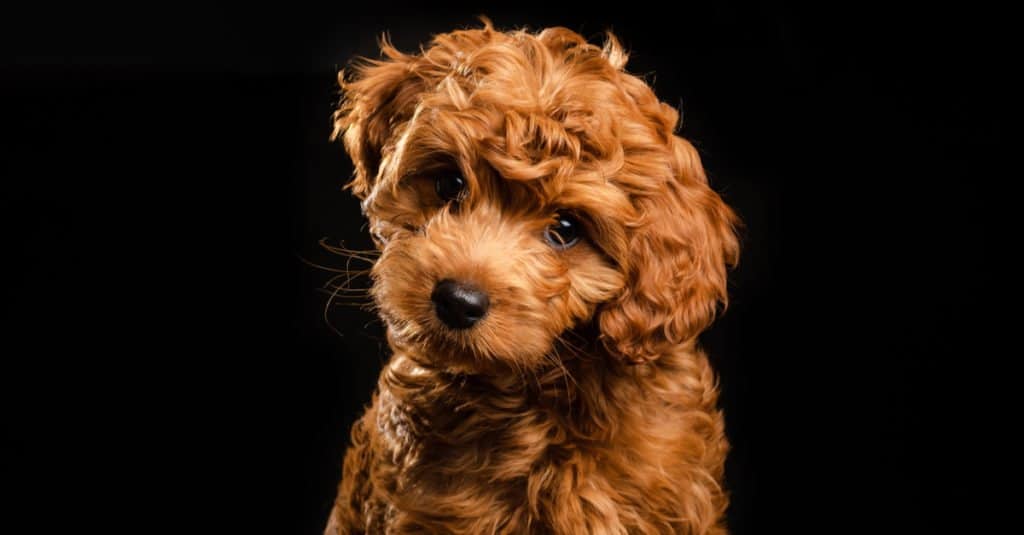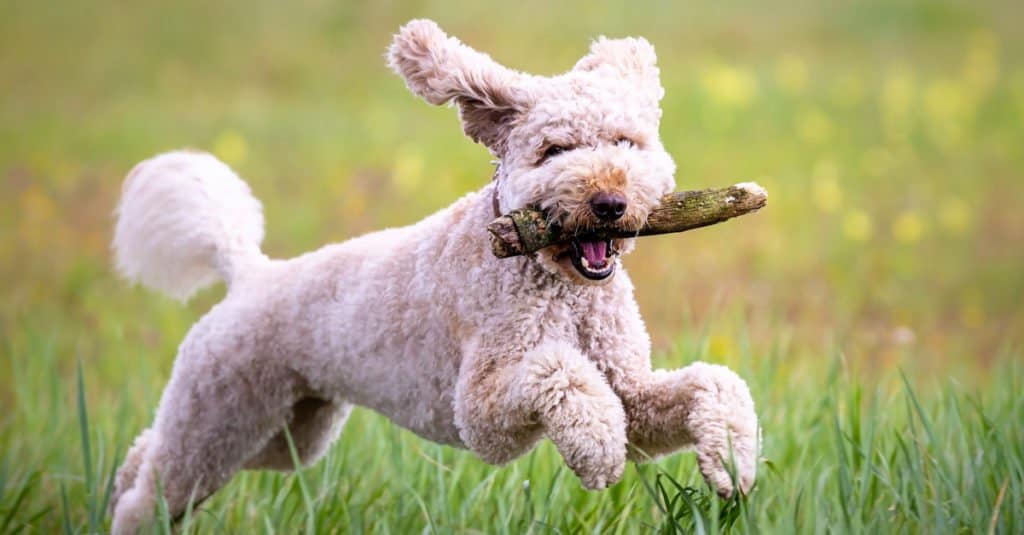If you’re looking for a small dog that is adorable and doesn’t shed, a mini labradoodle might be just the right pet for your family. Find out what to expect when it comes to growth, training, and food for a mini labradoodle. You might just find that they are the perfect puppy for you.
One thing to note about mini labradoodle size is that there is no standard size or even features. Labradoodles are not recognized by the American Kennel Club as a distinct breed but instead are considered a mixed breed. This doesn’t stop many dog owners from falling in love with their cuteness and welcoming these furry members as family.
Mini Labradoodle Summary

A mini Labradoodle is a Labrador retriever mixed with a toy poodle.
©jadimages/Shutterstock.com
These small dogs are a mix of a Labrador retriever and a toy poodle. They tend to stay smaller and don’t shed, making them great pets for families in apartments or those who just don’t want to clean up dog hair often. Mini labradoodles are very similar to their larger relatives, the labradoodle, which is a mix of a Lab and a standard poodle. They can be standard, mini, or teacup-sized, depending on their genes and other factors. They are generally happy, trainable dogs who live happily alongside other pets and kids.
Mini Labradoodle Growth and Weight Chart by Age
| Age | Weight |
| Birth | 3-5 pounds |
| 1 month | 3-5 pounds |
| 6 weeks | 4-6 pounds |
| 2 months | 4-7 pounds |
| 3 months | 6-11 pounds |
| 4 months | 8-14 pounds |
| 5 months | 9-16 pounds |
| 6 months | 10-20 pounds |
| 7 months | 12-21 pounds |
| 8 months | 13-23 pounds |
| 9 months | 13-23 pounds |
| 10 months | 14-34 pounds |
| 11 months | 15-25 pounds |
| 12 months | 15-25 pounds |
| 2 years | 15-25 pounds |
When Will My Mini Labradoodle Stop Growing?

Expect your dog to run around, play with toys, and get involved with every family activity.
©KariDesign/Shutterstock.com
Most mini labradoodles stop growing around the 1-year mark. They might get a little bit bulkier between 12 and 18 months but they are generally their full adult height by then. Even weight gain slows down and is usually limited to just a pound or two. Because they are smaller dogs, lifestyle factors like diet and exercise can have a big impact on this breed’s overall weight and health.
The height and weight of an adult mini labradoodle can really vary. As you can see from the growth chart, a full-grown dog might be as small as 15 pounds or as large as 25 pounds. How does so much variation show up in the same type of dog? The answer lies in who their parents are and their lineage. Most mini labradoodles are bred from mini labradoodle parents. This is in contrast to a lab breeding with a toy poodle. While this was the origin of the breed, today’s puppies tend to come from parents who were also mini labradoodles. This means that puppies who have stronger or more dominant genes from their Labrador ancestors tend to be larger and exhibit those qualities. Puppies with strong genes from their toy poodle relatives are often smaller.
How Big Will My Mini Labradoodle Be When It’s Fully Grown?
One of the best ways to get an idea of how big your puppy will be as it grows is to look at its parents. If they were on the larger side, there’s a good chance that your puppy will be as well. Smaller parents often have smaller puppies as well. When they are born, you might not be able to tell right away if your puppy will be a larger or smaller dog. But by the time they are a few months old, if they are consistent at the top of the growth chart for their breed, that’s a trend that will likely continue.
Most mini labradoodles are between 15 and 25 pounds when they are fully grown. Keep in mind that this does vary and there are certainly puppies whose lineage is in line with a mini labradoodle who end up being larger. Dogs in this breed who are between 25 and 50 pounds are typically considered medium labradoodles. Those between 50 and 100 pounds are standard or full-size labradoodles. These are mixtures of labrador retrievers and standard poodles. But the further away the dog is from the original lab and poodle, the more variations there can be when it comes to size.
Consider a set of labradoodle parents, one a labrador retriever and the other a toy poodle. Their puppies will be a mix of the two. When their puppies have their own puppies, these grandpuppies can have traits from any of the four grandparent dogs. This means that even labradoodles who come from the same lineage can have different combinations of genes that result in different sizes, colors, and other features.
The Biggest Mini Labradoodle Ever Recorded

Labradoodles are larger versions of mini labradoodles and can get up to 100 pounds or more.
©iStock.com/EvgeniiAnd
Because there are multiple categories for labradoodles that are mainly based on size, the biggest mini labradoodle is really just a medium or standard labradoodle. Most mini labradoodles don’t get bigger than 28 pounds at the top of the scale.
When Should My Mini Labradoodle Be Spayed or Neutered?
It’s important to take care of your dog’s health, no matter the breed. A lot of routine health care and procedures occur for puppies before they are fully grown. However, you should still wait at least 6 months before spaying or neutering your mini labradoodle to allow them time to grow and develop. Most vets recommend spaying or neutering your small dog anytime between 6 and 9 months old. It’s best to wait longer for large-breed dogs, often as long as a year or more. Keep this in mind if your mini labradoodle turns out to be not so miniature after all. Of course, other health issues or complications may require that you wait longer to spay or neuter your dog. The American Kennel Club recommends talking to your vet to determine the best time for the procedure.
When Should My Mini Labradoodle Be House Broken?
Like other dogs, mini labradoodles can be trained to go to the bathroom in a designated spot. This is typically outside, although you may use puppy pads to help train them in the beginning. Most mini labradoodles are housebroken by 4 to 6 months old, although some stubborn puppies can take a few months longer to really get accident-free. Mini labradoodles are easy to train in most cases, thanks to their labrador retriever genes.
Keep in mind that these dogs are small and have small bladders so don’t expect them to go for a long time without a bathroom break. It’s generally good to give them a chance to go every few hours. As puppies, it is even more important because it is part of training them. Very young puppies will typically need to go to the bathroom within 30 minutes of eating or drinking.
When Should My Mini Labradoodle Stop Eating Puppy Food?

Feeding your dog a balanced diet can help them with a variety of potential health risks.
©sophiecat/Shutterstock.com
Small breed dogs are often ready to make the switch from puppy food to adult food around 10 months old. You might want to wait a bit longer, especially if you think that your mini labradoodle will be on the larger side and still has some growing to do. Puppy food tends to be higher in calories, fat, and protein than adult dog food. This ensures that puppies have the nutrients that they need since they grow at a more rapid pace.
Once you make the switch, look for a food that is made for small-breed dogs. Mini labradoodles have different nutritional needs than their large breed cousins. You can also talk to your vet if you are concerned about other areas of your dog’s health and get specialized food. In general, for mini labradoodles that are healthy and not overweight or underweight, a small-breed dog kibble is a good option.
When Will My Mini Labradoodle Start Losing Teeth?
Did you know that puppies lose their teeth? Just like human babies, puppies grow and lose puppy teeth to make room for their adult dog teeth. For mini labradoodles, this typically happens between 3 and 7 months old. During this teething time, provide plenty of chew toys for your puppy to gnaw on. This can provide some relief from the teething aches and pains. Look for a puppy-specific chew toy, however. Adult dog chew toys may be too hard for a puppy’s sensitive gums. Remember that mini labradoodle puppies are also quite small and may have trouble carrying a massive chew toy around when they want it.
When Should I Start Training My Mini Labradoodle?
These adorable dogs are easily trained, just like their labrador relatives. You can start around 8 weeks old. To begin training your puppy, create and stick to a consistent routine. You can also begin with basic commands so that they learn how to communicate with you. It’s important to start early enough so that your new puppy learns to follow commands. Many trainers recommend starting from the beginning by teaching them the words, although don’t expect to see much progress until they are around 2 months old.
Some breeders will teach new puppies basic commands and toilet training before they adopt them to new owners. While this isn’t standard practice, it can be nice to know that your pet is already used to training. This can make the puppy more expensive, however.
What Commands Should I Teach My Mini Labradoodle First?
The basic commands that work for most puppies also work for mini labradoodles. It’s best to start with “sit, stay, and come.” These help your pup know where you want them to be and can be especially important when they are around other dogs or people. Some dogs get nervous in these scenarios and benefit from staying close to their owners and knowing just where to go.
Mini labradoodles don’t chew as much as some other breeds but there may still be times when they need to be reminded to put something down. If your dog tends to get into food or plants, teaching them the command “drop it” or “leave it” might be especially important. Some foods are dangerous for dogs and you’ll want a way to tell your dog to drop something that could make them sick.
Pictures of Mini Labradoodles as Puppies

You can sometimes get a good idea of how big your labradoodle will be based on the proportions of their paws to the rest of their body as a puppy.
©gatien.a/Shutterstock.com
Pictures of Mini Labradoodles at 6 Months

Mini labradoodles often have tightly curled hair, a trait that they get from their poodle heritage.
©Lynxs Photography/Shutterstock.com
Pictures of Fully Grown Mini Labradoodles

Mini labradoodles do most of their growing by the time they are 1 year old.
The photo featured at the top of this post is © Unknown/Shutterstock.com
Ready to discover the top 10 cutest dog breeds in the entire world?
How about the fastest dogs, the largest dogs and those that are -- quite frankly -- just the kindest dogs on the planet? Each day, AZ Animals sends out lists just like this to our thousands of email subscribers. And the best part? It's FREE. Join today by entering your email below.
Thank you for reading! Have some feedback for us? Contact the AZ Animals editorial team.






